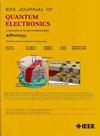注入锁定激光器的锁定时间分析
IF 2.2
3区 工程技术
Q3 ENGINEERING, ELECTRICAL & ELECTRONIC
引用次数: 0
摘要
利用速率方程分析了光注入锁定(OIL)固体激光器的瞬态特性,重点研究了锁定时间(从激光锁定到主激光频率所需的时间)如何受到注入强度、失谐频率和腔场初始相位的影响。特别是平均锁定时间,即两个激光信号之间随机初始相位差的平均锁定时间,被系统地研究了。在渐近稳定性和相空间轨迹分析的辅助下,研究表明,油激光器的动力学是相当复杂的,其行为是多样的。涉及平均锁定时间的研究结果表明,除了锁定边缘附近,平均锁定时间对频率失谐相当不敏感,在锁定边缘附近,可能发生极大的变化,范围从很小的值到很小的值,在很窄的间隔内。还发现,相对于注入强度,平均锁定时间存在趋势反转;随着注入强度的增加,锁紧时间开始减少,超过一定注入强度后,锁紧时间又开始增加。还预测了一些有趣的特性,例如瞬时锁定和伪稳定行为。本文还简要研究了注入光关闭后的瞬态过程,并与注入锁定过程进行了比较。这项研究的结果应该为探索各种潜在的石油应用的可行性、局限性和设计指南提供有用的见解,其中响应速度是重要的。本文章由计算机程序翻译,如有差异,请以英文原文为准。
Lock-Time Analysis of Injection-Locked Lasers
Transient characteristics of optical injection-locked (OIL) solid-state lasers are analyzed using rate equations, with a focus on how the lock-time, which is defined as the time required for the slave laser to lock onto the master laser’s frequency, is affected by the injection strength, detuning frequency, and cavity field’s initial phase. In particular, mean lock-time, the lock-time averaged over a random initial phase difference between the two laser signals, is systematically investigated. The study, aided by asymptotic stability and phase-space trajectory analyses, shows that the dynamics of OIL lasers is quite complex as well as diverse in its behavior. Findings involving the mean lock-time indicate that it is fairly insensitive to frequency detuning except near the locking edge, wherein extremely large variations can occur, ranging from a very small to a very large value in a narrow interval. It is also found that there is a trend reversal of the mean lock-time with respect to the injection strength; after initially undergoing a decrease with increasing injection level, the lock-time starts to increase once again beyond a certain injection strength. There are also some interesting features predicted, such as instantaneous locking and pseudo-stable behavior. The transient process following switching off of the injected light is also briefly investigated and compared to the injection-locking process. The results of this research should provide useful insight when exploring the feasibility, limitations, and design guidelines of various potential OIL applications in which the response speed is of importance.
求助全文
通过发布文献求助,成功后即可免费获取论文全文。
去求助
来源期刊

IEEE Journal of Quantum Electronics
工程技术-工程:电子与电气
CiteScore
4.70
自引率
4.00%
发文量
99
审稿时长
3.0 months
期刊介绍:
The IEEE Journal of Quantum Electronics is dedicated to the publication of manuscripts reporting novel experimental or theoretical results in the broad field of the science and technology of quantum electronics. The Journal comprises original contributions, both regular papers and letters, describing significant advances in the understanding of quantum electronics phenomena or the demonstration of new devices, systems, or applications. Manuscripts reporting new developments in systems and applications must emphasize quantum electronics principles or devices. The scope of JQE encompasses the generation, propagation, detection, and application of coherent electromagnetic radiation having wavelengths below one millimeter (i.e., in the submillimeter, infrared, visible, ultraviolet, etc., regions). Whether the focus of a manuscript is a quantum-electronic device or phenomenon, the critical factor in the editorial review of a manuscript is the potential impact of the results presented on continuing research in the field or on advancing the technological base of quantum electronics.
 求助内容:
求助内容: 应助结果提醒方式:
应助结果提醒方式:


